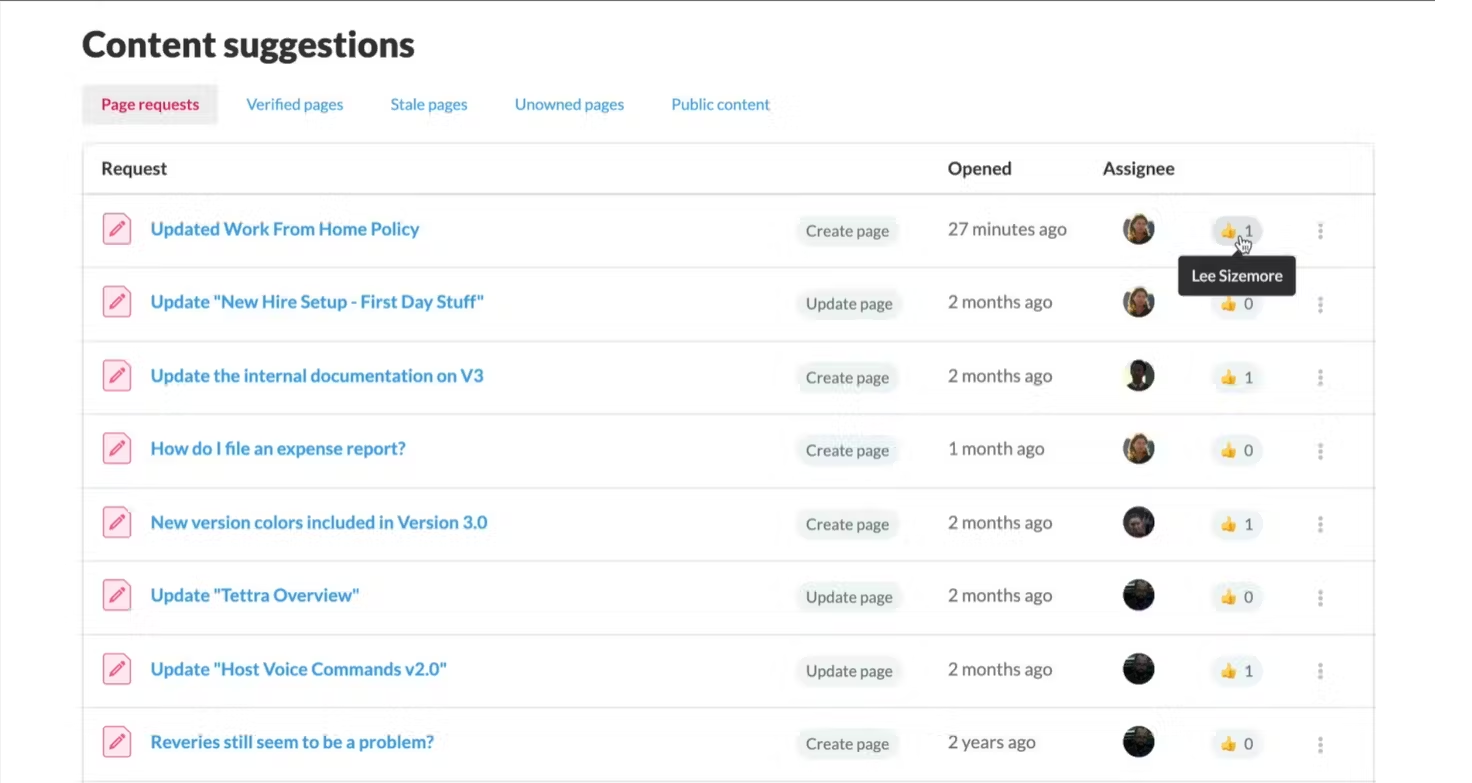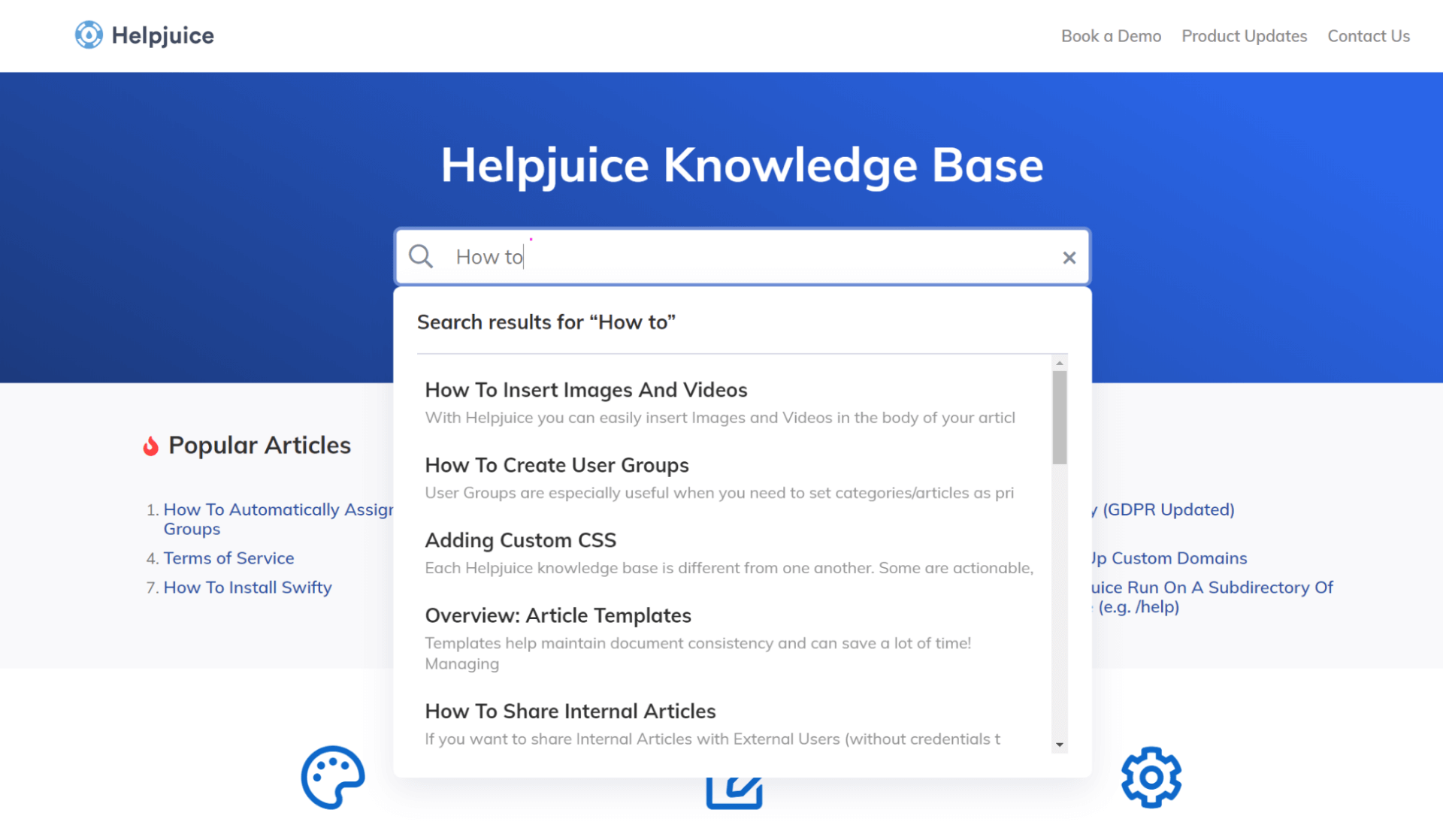Knowledge is a crucial asset for any organization. However, when this information remains trapped in silos, scattered across emails, documents, and individual minds, it leads to frustration, wasted time, and missed opportunities.
A study by IDC revealed that Fortune 500 companies lose around $31.5 billion annually due to inadequate knowledge sharing. A knowledge management system (KMS) can help with this.
A KMS helps transform this scattered information into a centralized, easily accessible knowledge hub, empowering employees to find answers quickly, learn from each other, and make informed decisions.
In this blog, we’ll discuss what a KMS is, discuss its benefits and key features, and learn how to implement it. We’ll also explore the best Knowledge Management tools.
What Is a Knowledge Management System?
A knowledge management system helps you capture, store, and share knowledge across all departments in your organization.
The primary goal of a KMS system is to bring all fragmented pieces of information together on a single platform where employees and customers can access it conveniently. It acts as a one-stop information center that fosters team collaboration and improves work efficiency.
A knowledge management system can help you cater to your employees as well as customers. For example, a KMS for your employees can offer the following:
- Employee handbooks
- How-to articles and videos
- Subject matter expertise
- Latest company developments
- Company work processes
- Previous and new projects
- Company vision, mission, clients, and much more.
On the other hand, a KMS built for customers or your support team comprises:
- Product or service-related information
- Product features and how they work
- Video tutorials, how-to articles
- Safety precautions
- Troubleshooting tips and FAQs
- Subscription details, payment process, and much more.
What Is the Difference Between Knowledge Management & Knowledge Management System?
Knowledge management (KM) or Enterprise Knowledge Management is a broader concept that encompasses an organization’s overall strategy and processes for capturing, organizing, storing, sharing, and utilizing its collective knowledge. It’s about fostering a culture of learning, collaboration, and continuous improvement.
On the other hand, a knowledge management system (KMS) is a specific tool or technology that facilitates the implementation of knowledge management practices. It’s the platform or software used to create, store, organize, and share information, such as a knowledge base, intranet, or document management system.
So, KM is the overarching philosophy, while a KMS is the practical tool used to implement it.
What Types of Knowledge Should Be Included in a Knowledge Management System?
The types of knowledge management systems are not just about content management vs knowledge management; it is mainly divided into two parts:
1. Public or External KMS
A public knowledge management system focuses on your external audience, i.e., customers. It acts as a customer self-service portal comprising well-structured articles on your products or services.
Customers can access this platform on the go to solve problems independently. Depending on your goals, you can have a public KMS in various formats: knowledge base, help center, FAQs, manuals, help sites, and more.
For instance, an FAQ section is the right choice if you want a simple help section that addresses common customer questions. But, if you want a comprehensive resource that covers products and services in detail – a knowledge base would fit the bill.
2. Private or Internal KMS
An internal or private KMS is the opposite of a public or external KMS. It is targeted towards your internal audience, i.e., employees.
It works as a one-stop platform for your employees to quickly access your company’s best practices, code of conduct, policies, and any other information they need.
An internal KMS helps you in employee onboarding, cross-department collaboration, and knowledge sharing.
Some popular formats of an internal KMS include an internal knowledge base, private wiki, employee handbook, HR documentation, and training documentation.
What Are the Key Components of a Knowledge Management System?
A knowledge management system (KMS) includes components that ensure efficient knowledge capture, storage, sharing, and utilization. Here are the essential ones:
- Knowledge Repository: A central database to store and organize knowledge, such as documents, FAQs, tutorials, and case studies.
- Content Creation Tools: Features for creating and managing knowledge, like document editors and collaboration tools.
- Search Functionality: An efficient Knowledge Base search engine to help users find relevant information quickly.
- Categorization & Tagging: Methods to classify and tag knowledge for easy access and navigation.
- Collaboration Tools: Platforms for team collaboration, allowing users to contribute and share knowledge.
- Access Control: Permission settings to manage who can view, edit, or contribute to the knowledge base.
- Analytics & Reporting: Tools to track user engagement, content usage, and system performance.
- Integration with Other Systems: Connectivity to other software, such as CRM, project management, or communication tools, for seamless workflows.
What Are the Benefits of Implementing a Knowledge Management System?
A knowledge management system helps boost your team’s productivity, encourage collaboration across departments, and more. Here are some key benefits of adopting a KMS:
Prevent Information Silos
Information silos happen when crucial business information is locked in years-old files or folders, with only a few people knowing their whereabouts. Another reason is when department-specific information remains in the confines of a few teams without a proper system for sharing it with others.
A KMS centralizes knowledge across departments, allowing employees at all levels to access critical business information easily. Employees can also use the KMS to share their insights and experiences with colleagues, which helps foster a learning-focused culture in your organization.
Boost Team Productivity
Productivity suffers when employees spend hours digging through scattered documents to find the information they need.
A KMS guides employees through the why, how, and what of everything related to your business. Knowledge management tools store all the information in a centralized repository and ensure employees get what they need with a few clicks, boosting team productivity.
Control Knowledge Loss
As employees leave or retire, the knowledge accumulated over the years goes with them. If this knowledge is not preserved, it can significantly hamper your internal processes.
A knowledge management solution can prevent this. It gives employees a platform to share their institutional knowledge regularly with colleagues across departments. This way, the knowledge stays with you forever.
Improve Customer Satisfaction
If you use the KMS as a customer-facing knowledge base, help center, or user manual, you make it available to your customers for self-service. It provides customers with instant help whenever they encounter an issue with your products or services.
It also helps your support staff stay updated with product information and deliver timely help to customers across chat, social media, calls, or emails. This way, your support staff receives fewer tickets and has more time to focus on critical issues that require careful analysis.
Foster Innovation & Collaboration
A knowledge management system brings all your employees under a single roof, where they can collaborate on projects, provide feedback, and solve problems with each other’s support.
You can assign specific roles to team members so that they can work collaboratively with minimum friction. Easy access to expert knowledge aids employees in performing their jobs effectively.
What Are the Steps to Implement a Knowledge Management System?
Implementing a knowledge management system (KMS) requires careful planning, strategic execution, and ongoing optimization. Here are the critical steps involved:
Outline Your Objectives & Scope
Start by clearly defining your KMS’s goals. Are you looking to improve customer service, streamline onboarding, foster innovation, or enhance decision-making?
Identify the areas where knowledge management can bring the most value to your organization.
Win Leadership’s Support
Gaining support from leadership is crucial for successful KMS implementation. Communicate the benefits of a KMS, emphasizing its potential to improve efficiency, productivity, and overall business performance.
Securing leadership buy-in will ensure resource allocation and smooth adoption across the organization.
Carry Out a Knowledge Audit
Assess your organization’s existing knowledge assets. Identify where knowledge resides, who possesses it, and how it’s being shared.
This audit will help you understand your knowledge landscape and identify areas for improvement.
Select the Right KMS Tool
Choose a feature-rich Knowledge Management System platform that meets your needs, budget, and technical capabilities.
Consider factors like ease of use, scalability, security features, integration options, and vendor support.
Create a Knowledge Management Strategy
Develop a comprehensive strategy that outlines your knowledge management goals, processes, and guidelines.
This strategy should define how knowledge will be captured, stored, organized, shared, and utilized within the organization.
Add Content to Your KMS
Start by migrating existing knowledge assets into your KMS. Encourage employees to contribute their expertise and create new content.
Ensure that information is well-structured, categorized, and easily searchable.
Promote Adoption & Engagement
Communicate the KMS’ benefits to your employees and provide training on how to use it effectively.
Encourage a culture of knowledge sharing and collaboration, encouraging active participation and contribution.
Monitor, Evaluate & Optimize
Track key metrics to measure your KMS’ effectiveness. Gather user feedback and identify areas for improvement.
Continuously optimize your KMS to align with your evolving business needs and objectives.
What Are the Challenges in Deploying a Knowledge Management System?
Organizations can encounter challenges while implementing a KMS, hindering successful adoption and realizing its full potential. Here are some of those:
Ensuring Buy-in & Engagement
Gaining support and active participation from employees at all levels can be a significant challenge. Resistance to change, lack of understanding of the benefits, or perceived lack of time can hinder engagement with the KMS.
Sustain Content Quality & Consistency
Ensuring information accuracy, relevance, and consistency within the KMS requires ongoing effort. Outdated or inaccurate content can erode trust and diminish the system’s value.
Selecting the Right KMS Tool
Selecting a KMS that aligns with your organization’s specific needs, budget, and technical capabilities can be challenging.
Evaluating different platforms, considering integration requirements, and ensuring scalability are crucial factors.
Integrating with Existing Systems
Integrating the KMS with existing business systems and workflows can be complex. Ensuring seamless data flow and compatibility with other tools requires careful planning and technical expertise.
Measuring & Demonstrating ROI
Quantifying a KMS’s return on investment (ROI) can be difficult. Identifying and tracking relevant metrics to demonstrate the system’s impact on efficiency, productivity, and cost savings is essential.
Overcoming Knowledge Silos
Breaking down departmental silos and fostering a culture of knowledge-sharing across the organization can be a challenge. Encouraging collaboration and open communication is crucial for KMS’ success.
Addressing Security & Privacy Concerns
Protecting sensitive information and ensuring compliance with data privacy regulations are critical considerations. Implementing appropriate security measures and access controls is essential.
What Are the Best Practices for Deploying a Knowledge Management System?
Deploying a knowledge management system (KMS) requires more than choosing the right software. Here are some essential best practices for the same:
Cultivate a Knowledge-Sharing Culture
Beyond simply providing a KMS; actively foster a culture where knowledge sharing is valued and rewarded.
Encourage employees to contribute their expertise, share best practices, and engage in discussions. Recognize and incentivize knowledge contributions to reinforce this culture.
Champion Knowledge Champions
Identify and empower individuals within different teams or departments to be knowledge champions.
These individuals can promote the KMS, provide guidance to colleagues, and encourage active participation.
Prioritize Knowledge Accessibility
Ensure your KMS is accessible to all employees, regardless of location or device. Optimize for mobile access, provide offline access options, and integrate with commonly used platforms to maximize reach and convenience.
Implement a Robust Search Functionality
Equip your KMS with a powerful search engine that can quickly and accurately retrieve relevant information.
Consider features like advanced search filters, auto-complete, and related content suggestions to enhance the search experience.
Establish a Content Governance Model
Define clear roles and responsibilities for content creation, editing, and approval. Implement a content review process to ensure accuracy, consistency, and adherence to quality standards.
Leverage Gamification & Incentives
Introduce gamification elements like badges, points, and leaderboards to motivate employees to contribute to and engage with the KMS.
Consider offering rewards or recognition for valuable contributions.
Promote Knowledge Reuse & Repurposing
Encourage the reuse of existing knowledge assets to avoid duplication of effort and maintain consistency.
Implement templates, content snippets, and version control to facilitate knowledge reuse.
Gather & Analyze User Feedback
Regularly solicit user feedback to understand their needs and identify areas for improvement. Analyze usage data and feedback to optimize your KMS and ensure it remains relevant and valuable.
Continuously Evaluate & Improve
Assess the effectiveness of your KMS regularly and make adjustments as needed.
Stay informed about new knowledge management trends and technologies to ensure your system remains up-to-date and optimized.
Which Are the Top 5 Knowledge Management System Tools?
Knowledge management software systems help organize, store, and share information efficiently, enabling teams to access, collaborate, and use knowledge effectively. Here are the top 5 tools.
1. ProProfs Knowledge Base – Best for Easily Creating & Managing Help Sites, Manuals & Private Knowledge Bases
ProProfs Knowledge Base has a user-friendly interface and robust features that help centralize information. It acts as a single source of truth, providing a repository for all critical information, including company policies, product documentation, process guidelines, and training materials.
It also enhances collaboration and knowledge sharing through features like internal comments, version control, and co-authoring. This facilitates seamless communication and teamwork, allowing employees to contribute their expertise, provide feedback, and work together to improve the quality of information.
What You Will Like:
- Offers powerful search capabilities, ensuring that users can quickly and easily find the information they need
- Customizable templates for quick help site creation
- Multi-branding to create different versions of a single site by applying different branding styles to it
- Ability to control the layout, format, and presentation of your knowledge base with the help of CSS
- Analytics feature for valuable insights into how content is being used.
What You May Not Like:
- No downloadable or on-premise version
- Dark user interface option is not available
- No dedicated account manager for the free plan, unlike the paid one.
Pricing:
Forever Free Plan with all the premium features for small teams. Paid plan starts at $49/author/month.
2. HelpCrunch – Best for Creating a Structured Help Center

HelpCrunch enables powerful features like AI-powered content generation and extensive customization options. It streamlines the process of building, organizing, and sharing knowledge, ultimately enhancing customer self-service and reducing support costs.
Its AI-powered editor simplifies and accelerates content creation, allowing users to effortlessly refine their articles by shortening, expanding, or rephrasing text, adjusting the tone of voice, and even translating content automatically.
What You Will Like:
- Allows you to personalize it with your domain, logo, color scheme, and CSS
- Enables a real-time WYSIWYG editor, making it easy for anyone to create and manage knowledge base content
- Provides actionable metrics to track article views and ratings, helping businesses identify content gaps through failed search reports.
What You May Not Like:
- Lacks multilingual capabilities
- Cannot edit the message after it has been sent to the app.
Pricing:
HelpCrunch offers a free trial. Paid plan starts from $12/user/month.
3. Tettra – Best for Saving Reusable Answers & Keeping Them Up-To-Date With Automation

Tettra’s core strength lies in its ability to connect employees with the information they need when they need it, eliminating the time wasted searching through scattered documents and emails.
Its AI-powered knowledge base allows users to seamlessly create a comprehensive knowledge repository using new or existing content. The platform’s intelligent search functionality ensures that team members can quickly find answers to their questions and access relevant information in seconds.
What You Will Like:
- Knowledge management automation to streamline the process of verifying information accuracy, identifying knowledge gaps, and managing content updates
- Includes a powerful search functionality that helps users find the information they need quickly
- Seamlessly integrates with other popular tools such as Google Drive, GitHub, and Trello.
What You May Not Like:
- The page editing mode lacks robust customization options for different fonts, font sizes, and colors, and more flexibility in creating tables
- Can be less intuitive for users not familiar with Slack or Microsoft Teams.
Pricing:
Paid plan stats at $4/user/month.
4. Helpjuice – Best for Creating FAQ Articles

Helpjuice offers a seamless and user-friendly experience for both content creators and end-users. Features like a powerful WYSIWYG editor, customizable themes, and multi-language support make it easy to create and manage a knowledge base that aligns with your brand and caters to a diverse audience.
Its AI-powered search functionality ensures that users can quickly and effortlessly find the information they need, even if they don’t know the exact keywords to use. Its step-by-step tutorial creator empowers users to create interactive guides and tutorials that simplify complex processes and enhance knowledge absorption.
What You Will Like:
- Integrates seamlessly with various other software applications, such as CRM and help desk tools
- Robust security features like Access Control, SSO & User Roles
- Supports 300+ languages.
What You May Not Like:
- No folder system for images, so they quickly get lost in an endless feed
- Could use a feature to manage article comments and tasks in the platform.
Pricing:
A free trial is available. Paid plan starts at $120/month/4 users.
5. Document360 – Best for Creating Online Documentation

Document360 offers a powerful Markdown editor, customizable themes, and a variety of formatting options to create professional and engaging knowledge base articles. Furthermore, its AI-powered search functionality ensures that users can quickly find the information they need, even if they don’t know the exact keywords to use.
It also simplifies knowledge management with features like version control, category manager, and bulk operations, allowing you to maintain accuracy and keep your content updated. It also integrates seamlessly with popular tools like Slack, Microsoft Teams, and Zapier, enabling you to connect your knowledge base with your existing workflows and enhance collaboration.
What You May Like:
- Analytics dashboard, which provides valuable insights into user behavior and content performance
- In-line comments are needed to collaborate with authors on your team to write or review published and draft articles
- Enables a detailed trail of team account activity in the knowledge base portal.
What You May Not Like:
- Analytics and integration features are available only in the top-tier plans
- New users may find the interface and certain features overwhelming without sufficient onboarding.
Pricing:
A free plan is available. Paid plan starts at $199/project/month.
What Are the Essential Features of a Knowledge Management System?
A knowledge management system (KMS) is more than just a digital filing cabinet. Let’s explore the essential components that make a KMS truly effective.
Centralized Collaboration
This allows different individuals and teams to join forces and participate in content-building. It has a user management system in place, wherein you can add new users and groups and allot them roles like writer, editor, administrator, or viewer — so they can work together in a shared space.
This collaborative system streamlines the content crafting process, as everyone knows what they are supposed to do. There are no clashes among users, and your business knowledge always stays updated and fresh for everyone to use.
Uninterrupted Search
Thanks to its Google-like search system, a knowledge management system makes information gathering faster and easier.
The AI-powered search system shows the most relevant article suggestions at the top and loosely related content pages towards the bottom. This allows users to quickly find the information they need and work without sifting through multiple files and folders.
Easy Accessibility
A knowledge management system must be easily accessible and provide on-demand information so users don’t struggle with adoption.
You need to look for a system that facilitates accessibility across various devices, such as phones, tablets, and laptops. This will help your employees and customers access everything they need on the go. A KMS with easy accessibility also allows remote teams to learn and contribute quickly.
Customization Options
A robust knowledge management system offers a wide range of customization options to help you keep the content aligned with your brand.
From adding your company’s logo and brand name and choosing your favorite font styles to picking themes that resonate well with your brand, a KMS gives you the power to tailor your knowledge base the way you want. You also get a library of themes and color schemes to pick from.
Custom Workflows
Custom workflows allow you to streamline the review process of your knowledge base posts. Such a system can have four to five statuses: Draft, Published, Ready for Review, In Progress, and Custom Status.
These statuses help determine the stage of each post so that your contributors can enjoy a conflict-free documentation process. You can use the custom workflows and approval process to ensure your knowledge base content is helpful, accurate, and relevant.
Smart Reports
How do you know if your KMS performs well and successfully addresses user concerns? That’s where reports help. Reports provide a graphical and tabular representation of your KMS’s performance, from failed searches and poorly rated articles to inactive or broken links.
These comprehensive insights give a transparent picture of how adept your KMS is at solving the problems of your customers and employees. You can leverage the reports to modify your content or add more quality articles to your KMS.
Integrations
Integrations are essential for maximizing the functionality of your knowledge management system by connecting it with third-party applications.
A KMS with powerful third-party integrations can help users experience various other functionalities that a standalone knowledge management system cannot provide. It also creates a distraction-free experience, as users don’t have to switch back and forth between tools.
What Are Some Knowledge Management Use Cases?
Knowledge management is not just limited to storing documents. Here are some essential knowledge management use cases:
Customer Self-Service
For creating a comprehensive knowledge base or help center that empowers customers to find answers to their questions and resolve issues independently.
Employee Onboarding & Training
For streamlining the onboarding process for new employees by providing easy access to company policies, procedures, training materials, and best practices.
Product Documentation
For developing detailed product documentation, including user manuals, tutorials, and troubleshooting guides, to help users understand and utilize your products effectively.
Internal Collaboration & Communication
For fostering a knowledge-sharing culture within your organization by providing a platform for employees to collaborate, share ideas, and document their expertise.
Decision-Making & Problem-Solving
To equip your teams with the information and insights they need to make informed decisions and solve problems effectively. A centralized knowledge base provides a single source of truth.
Process Improvement & Standardization
To document and standardize critical processes and procedures within your organization to ensure consistency, efficiency, and compliance.
Innovation & Research
For capturing and sharing research findings, best practices, and lessons learned to foster innovation and continuous improvement.
Compliance & Risk Management
To maintain a centralized repository of policies, regulations, and compliance procedures.
Enable Team Collaboration & Customer Satisfaction with KMS
A knowledge management system (KMS) is a powerful tool that can transform how your organization captures, shares, and utilizes knowledge. By breaking down information silos, enabling collaboration, and empowering employees with easy access to information, a KMS can help improve efficiency, productivity, and knowledge sharing.
ProProfs Knowledge Base‘s intuitive interface, powerful features like AI-powered search and robust analytics, and seamless integrations make it an ideal platform for building a knowledge-driven culture. You can request for a demo or explore the tool more below.
FREE. All Features. FOREVER!
Try our Forever FREE account with all premium features!







